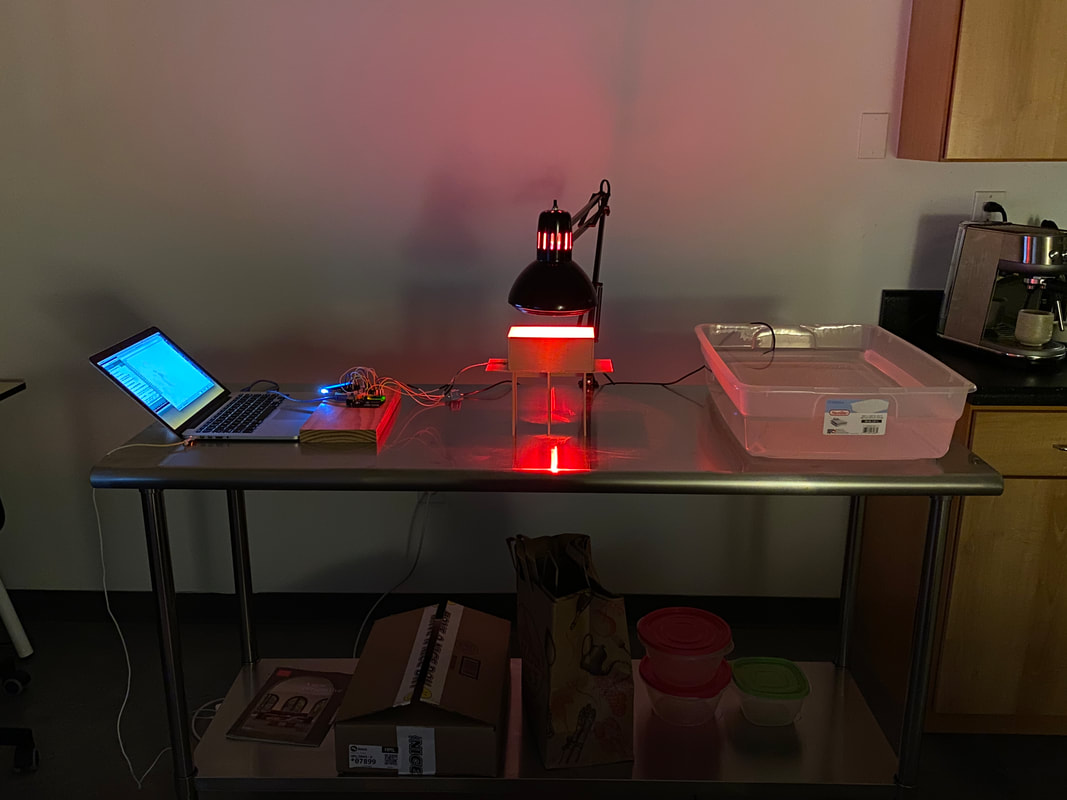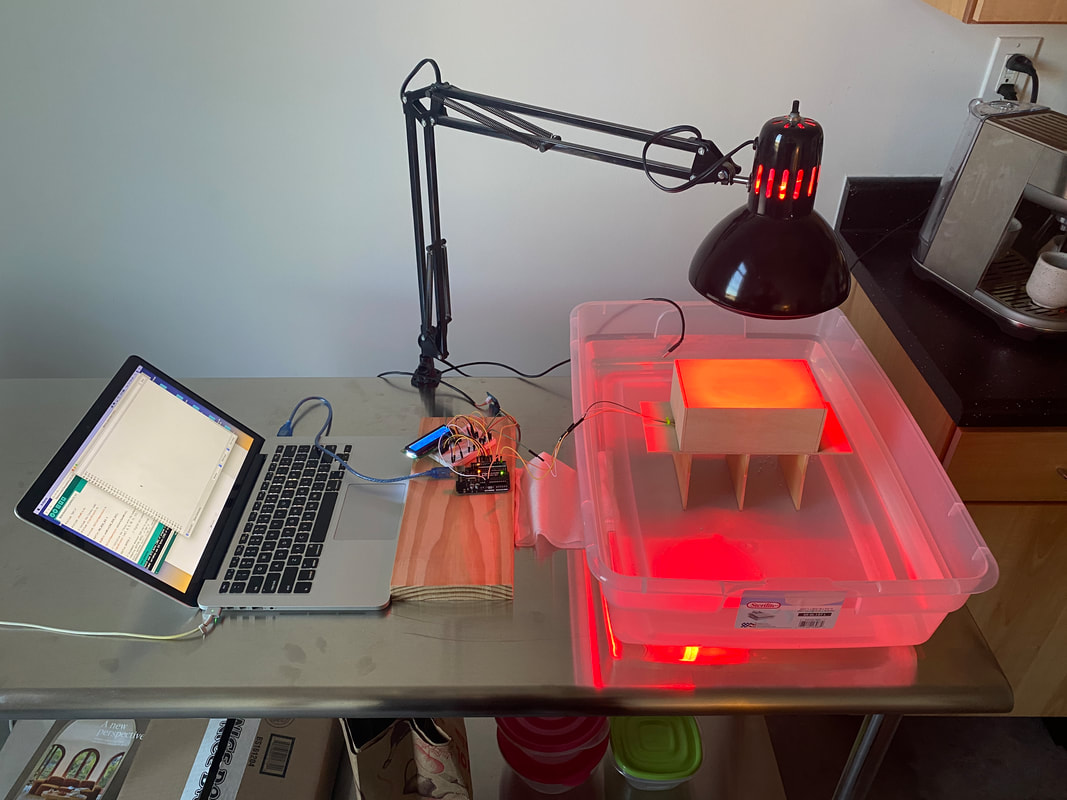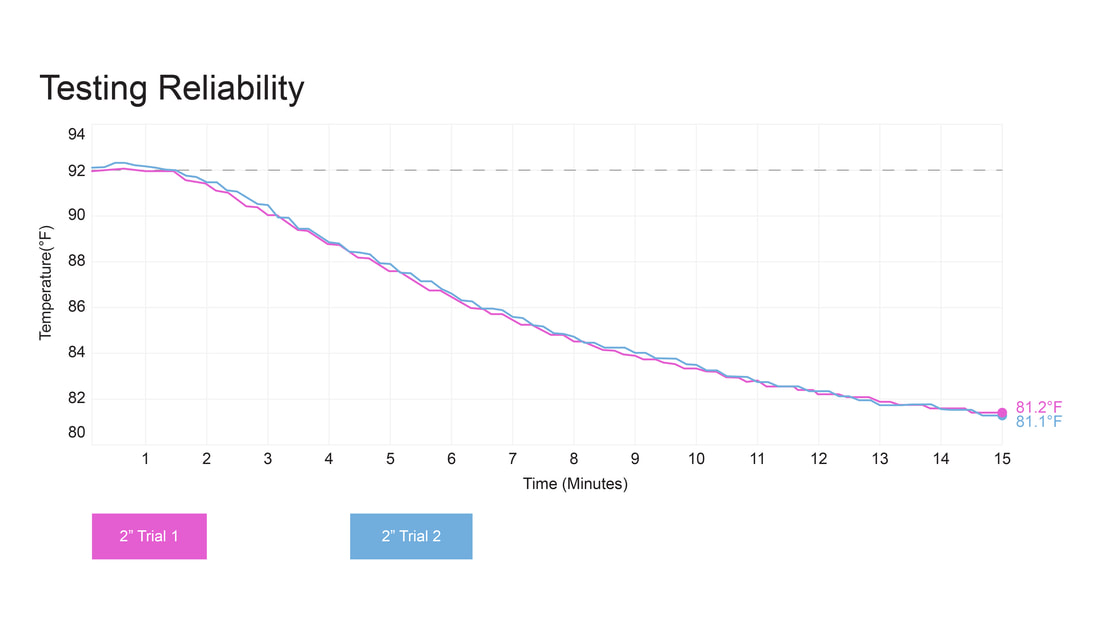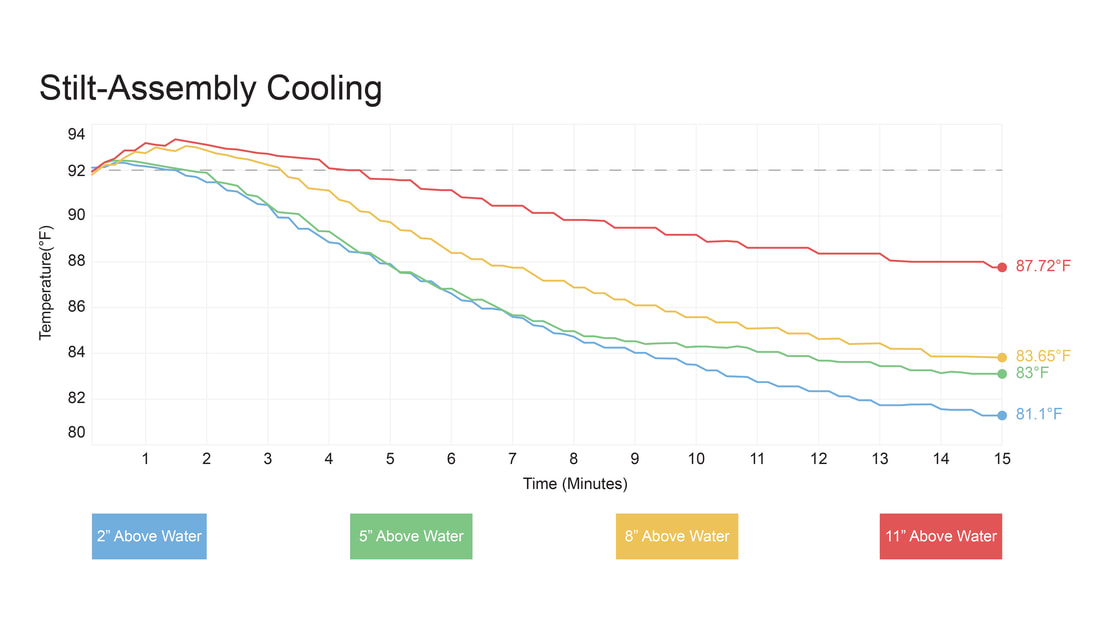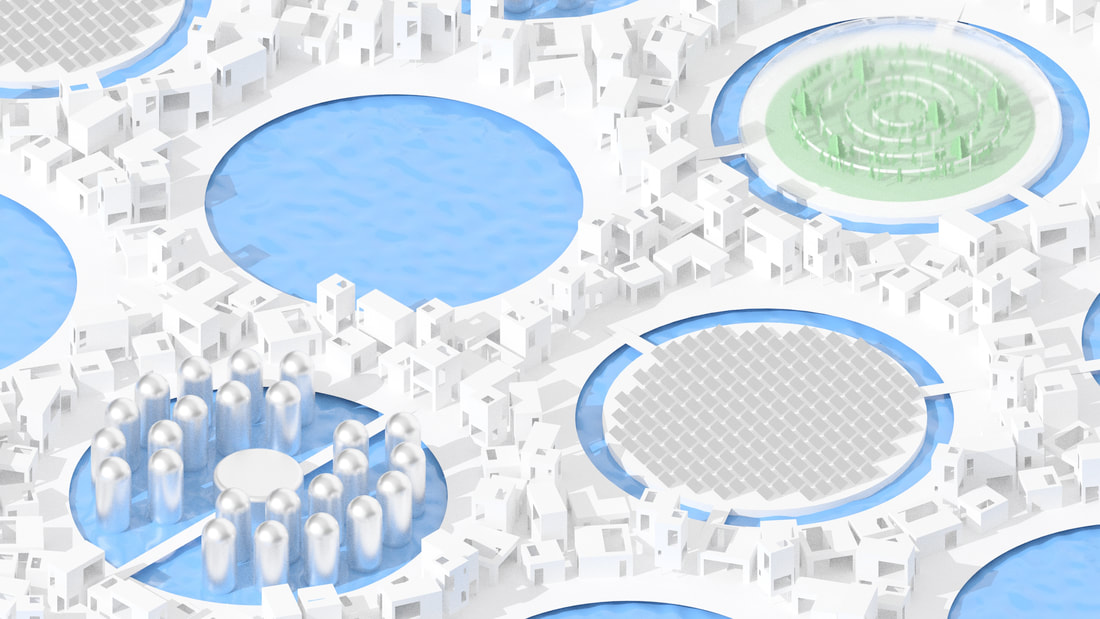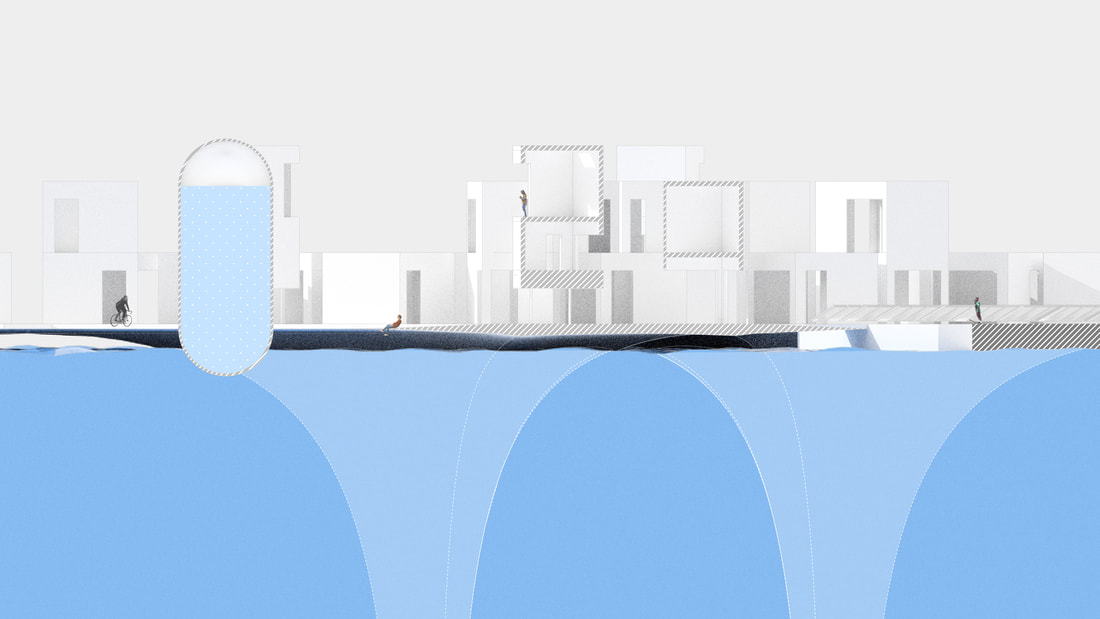Results
The graph above demonstrates the ability to repeat the experiment, with reasonably controlled variables, and produce comparable results. Using the low set of stilts in two tests, we can see that the collected temperature data lines up very closely, suggesting that measurements taken will be reliable.
The graph above compares temperature data from the range of stilt assemblies. Starting at a preconditioned temperature of about 92 degrees, and a standardized water temperature of 75 degrees, they are placed in the bath and temperatures are recorded over the span of 15 minutes. The data collected, once displayed, presents fairly clearly that the proximity to the water has an effect on the temperature of the dwelling or, in this case, the heated volume. These findings support the original hypothesis that as the distance between the water and volume decreases, the ability to be cooled increases.
Results Statement
Based on the collected data at this point in the process, the initial hypothesis (that assemblies closer to the water will have a higher ability to be cooled) appears to be correct.
Originally this was believed to be a result of efficient convective cooling in the system. However, after presenting the findings, there is reason to believe that part of the cooling is actually occurring through conductive means. The stilts / fins that sit in the water actually absorb water, as they are made of wood. This makes the wood more conductive for heat transfer as it, through capillary action, pulls water closer to the heated volume. This could be a reason that the results of the data were so clear, even at this scale. This will be expanded upon further down on this page.
Originally this was believed to be a result of efficient convective cooling in the system. However, after presenting the findings, there is reason to believe that part of the cooling is actually occurring through conductive means. The stilts / fins that sit in the water actually absorb water, as they are made of wood. This makes the wood more conductive for heat transfer as it, through capillary action, pulls water closer to the heated volume. This could be a reason that the results of the data were so clear, even at this scale. This will be expanded upon further down on this page.
Projected Design
Assuming that the relationship in the collected data is a result of effective conductive cooling, we can begin to speculate about how our buildings and cities engage the water and benefit from its cooling properties.
To position this phenomenon relative to a projected circumstance in the world, we may look to global climate change.
Greenhouse gasses are accumulating. Polar ice caps are melting, prompting a rise in water levels. We are approaching a global catastrophe at an alarming pace, and large-scale contributing factors have not been effectively managed. Land values have the potential to reach exorbitant new heights in the wake of higher sea levels, as a lack of uncontrolled property and blurred territorial boundaries will prompt a new land-rush. In the foreseeable future, we may need to contend with more strategic modes of living as a result of our carelessness. In a world where we have no access to land, resources, or means of cooling as we bake ourselves in the gasses and pollutants we have created, where can we go?
Perhaps to the sea?
To position this phenomenon relative to a projected circumstance in the world, we may look to global climate change.
Greenhouse gasses are accumulating. Polar ice caps are melting, prompting a rise in water levels. We are approaching a global catastrophe at an alarming pace, and large-scale contributing factors have not been effectively managed. Land values have the potential to reach exorbitant new heights in the wake of higher sea levels, as a lack of uncontrolled property and blurred territorial boundaries will prompt a new land-rush. In the foreseeable future, we may need to contend with more strategic modes of living as a result of our carelessness. In a world where we have no access to land, resources, or means of cooling as we bake ourselves in the gasses and pollutants we have created, where can we go?
Perhaps to the sea?
Only through a more thoughtful and non-parasitic relationship with water can we hope to survive in the world that we have defined. In the proposed strategy for deploying aqua-cities around the world, inhabitants and infrastructure will have a more symbiotic relationship with water and use it to support human life past a global climate event. Rather than trying to adapt more efficient cooling technology to fight increased global temperatures on land, settlements are able to capitalize on the climate that exists on the water to passively cool their dwellings. In addition to passive cooling, there is an opportunity to utilize desalination and hydroponics in the establishment of a sustainable food and water source, all supplied by solar arrays that would provide power to the inhabitants and infrastructure of the city. By repositioning water as a valuable resource that we share space with in our daily lives, and not a quickly accessible commodity for temporary use, we may utilize it in a more conscious way that extends our lives and the life of the planet.
Conclusion
To conclude, this experiment tested the extents of the cooling potential of water, and began to explain the strategy of a long-existing building typology. The results show that there is a measurable difference in potential for cooling as dwellings are constructed closer to water. Over a period of 15 minutes, there was a difference in temperature of 6.62 degrees Fahrenheit between the highest and lowest assemblies, which were constructed at 11 inches and 2 inches above the water, respectively.
Next Steps
Although the tests went smoothly and the data appears to support the original hypothesis, there is some gray area about what has generated those values. The heated volume was cooled, and the environment / testing apparatus were controlled and standardized, but the strategic transfer of thermal energy in the setup may not have been refined enough. While the purpose of the testing apparatus was to catalog data influenced by convective cooling, it’s likely that conductive cooling played a role as well. Having the stilts in the water allowed them to absorb water and bring it closer to the heated volume. Wet wood is more conductive and susceptible to act as a bridge for thermal energy than a less porous, dry material.
If prompted to redesign the testing apparatus, or tweak the construction process or methodology, I would opt for either a less porous material or a different assembly than stilts. Had the plinth and stilts been made of acrylic or another plastic, they wouldn’t absorb the water and wouldn’t carry thermal energy out of the heated volume, allowing the data to speak more clearly to the effects of conductive cooling. The same goes for a re-organized structural setup. Rather than projecting stilts down into the water, the heated volume could be placed atop a member that spans the length of the water bath with no need for stilts. This would eliminate any contact that the volume could make with the water and, thus, eliminate any chance for conductive heat transfer.
All that being said, If i were asked to start the whole process over again, I would adjust the research question to target conductive heat transfer as opposed to convective. At a couple points in the process, the scale of the testing apparatus was called into question, with concerns about its ability to collect such minute changes in temperature being communicated. I believe that conductive transfer would be both simpler to model, and easier to scale up. It would also be interesting to complete both versions of refined convective / conductive cooling experiments and compare the findings to see which plays a larger role, and if there is some way of hybridizing the two approaches at a larger scale and based on real life environmental factors.
If prompted to redesign the testing apparatus, or tweak the construction process or methodology, I would opt for either a less porous material or a different assembly than stilts. Had the plinth and stilts been made of acrylic or another plastic, they wouldn’t absorb the water and wouldn’t carry thermal energy out of the heated volume, allowing the data to speak more clearly to the effects of conductive cooling. The same goes for a re-organized structural setup. Rather than projecting stilts down into the water, the heated volume could be placed atop a member that spans the length of the water bath with no need for stilts. This would eliminate any contact that the volume could make with the water and, thus, eliminate any chance for conductive heat transfer.
All that being said, If i were asked to start the whole process over again, I would adjust the research question to target conductive heat transfer as opposed to convective. At a couple points in the process, the scale of the testing apparatus was called into question, with concerns about its ability to collect such minute changes in temperature being communicated. I believe that conductive transfer would be both simpler to model, and easier to scale up. It would also be interesting to complete both versions of refined convective / conductive cooling experiments and compare the findings to see which plays a larger role, and if there is some way of hybridizing the two approaches at a larger scale and based on real life environmental factors.
